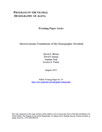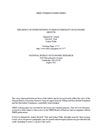-
Modeling Demographic Dividends, Fertility, and Income in Developing Countries
September 20, 2012 By Kate Diamond The poorest households gain the least when countries reap the demographic dividend, according to a preliminary draft of a new study by four Harvard School of Public Health researchers. In “Microeconomic Foundations of the Demographic Dividend,” authors David Bloom, David Canning, Günther Fink, and Jocelyn Finlay write that 18 years of Demographic Health Surveys (DHSs) from 60 developing countries show that while declining fertility rates and dependency ratios can lead to rising incomes on a nationwide level, sub-nationally those trends occur unevenly and mostly benefit wealthier households. Poorer households, meanwhile, are likelier to see slower fertility declines, delaying the economic gains that can result from demographic transitions, and increasing inequality. Importantly, the authors emphasize that the study reflects “the early stages of the demographic transition”; long-term economic effects of fertility decline, they write, “remain ambiguous.”
The poorest households gain the least when countries reap the demographic dividend, according to a preliminary draft of a new study by four Harvard School of Public Health researchers. In “Microeconomic Foundations of the Demographic Dividend,” authors David Bloom, David Canning, Günther Fink, and Jocelyn Finlay write that 18 years of Demographic Health Surveys (DHSs) from 60 developing countries show that while declining fertility rates and dependency ratios can lead to rising incomes on a nationwide level, sub-nationally those trends occur unevenly and mostly benefit wealthier households. Poorer households, meanwhile, are likelier to see slower fertility declines, delaying the economic gains that can result from demographic transitions, and increasing inequality. Importantly, the authors emphasize that the study reflects “the early stages of the demographic transition”; long-term economic effects of fertility decline, they write, “remain ambiguous.”
Similarly, in “The Effect of Interventions to Reduce Fertility on Economic Growth,” a recent National Bureau of Economic Research working paper, authors Quamrul Ashraf, David Weil, and Joshua Wilde model how changes in total fertility rates (TFRs) in developing countries impact per capita GDP. Relying on previous research on factors related to population dynamics and national income (including age structure, educational attainment, and fixed capital inputs like land) the authors created a model that assesses how a lower TFR can lead to eventual economic gains for the future (smaller) population. Sampling their model on Nigeria, the authors write that if the country were to follow the United Nation’s low-variant projection rather than the medium variant, per capita GDP would be 12.1 percent higher by 2055. While a number of significant assumptions underpin the specific data tested in the model, the authors conclude that for comparative purposes, the model nonetheless provides a valuable basis for assessing the degree to which lower TFRs can boost per capita GDP.
 A Publication of the Stimson Center.
A Publication of the Stimson Center.





